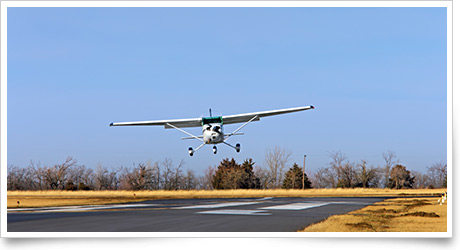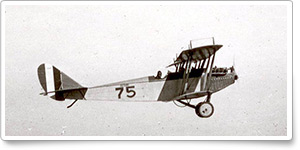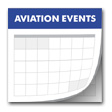Training Tips
Pounce on the pitch
 Identify this scenario: The aircraft is close to the ground with the power increasing and configuration changing; the pilot is applying strong forward pressure to the control yoke. Identify this scenario: The aircraft is close to the ground with the power increasing and configuration changing; the pilot is applying strong forward pressure to the control yoke.
Good work if you said this was the early stage of a balked landing or go-around. If there seems to be some dissonance between “power increasing” and “the pilot applying strong forward pressure to the control yoke,” think about your most recent practice go-around: What did you have to do to get the aircraft climbing?
Suppose you are established on a stabilized approach, power off and full flaps, on short final, trimmed so that it takes no special physical effort to maintain the pitch attitude and airspeed.
Suddenly an aircraft taxies onto the runway unannounced, or a ground vehicle appears without warning. You immediately commence a go-around: full power, aggressive right rudder to offset left-turning tendency, and (if recommended) an immediate partial retraction of flaps.
How will your aircraft, established in a power-off glide, respond to that quick burst of power?
It will respond by seeking to maintain its trimmed airspeed. It does that by pitching up—perhaps quite vigorously—as it pitches to the attitude that would maintain its trimmed airspeed at the new power setting.
Allowing the strong pitching-up response to proceed unrestrained could cause an excessive angle of attack. So as you busily work to arrest the descent, reconfigure, maintain directional control, and keep tabs on the goings-on below, add the necessary forward pressure (which also will help you quickly establish the recommended climb airspeed).
What about retrimming?
You’ll have your hands (and feet) full of aircraft control chores during this crucial time, but you may find that some “rough trim” helps you cope with the pitch forces created by the quick transition from power-off glide to full-throttle climb. But don’t become distracted by the urge to trim.
“As soon as the appropriate climb airspeed and pitch attitude are attained, the pilot should ‘rough trim’ the airplane to relieve any adverse control pressures. Later, more precise trim adjustments can be made when flight conditions have stabilized,” explains a discussion of go-around technique in the Airplane Flying Handbook.
A go-around commenced at low altitude is among the highest of high-workload scenarios. Whenever you must divide your attention between aircraft control tasks and conflicting traffic, remember: Fly the airplane first!
Flight Training News
 Learn the limitations of glass-cockpit technology Learn the limitations of glass-cockpit technology
Pilots shouldn’t rely solely on in-cockpit avionics such as multifunction displays to keep them out of severe weather or temporary flight restrictions. The avionics systems and subscription services have limitations and may not show real-time weather and temporary flight restriction information. Read more >>
Fly like a fighter: Don’t let your guard down
When a group of fighters let their guard down on a training mission, their counterparts attacked with such force the mission lasted just 3.5 minutes. “Negative contact” in the military doesn’t mean fighter pilots can relax, and a silent CTAF at an airport doesn’t mean you can let your guard down either. Read more >>
Aviation life coaching helps pilots face confidence issues
Pilots are seen as confident, but some may face unique fears and lack the tools needed to deal with in-flight emergencies. So flight instructor Mark Ross has created Aviator Life Coaching to help pilots discuss and address the issues that they find difficult to face. Ross is partnering with an instructor pilot in the U.S. Air Force Reserves who teaches future fighter pilots how to handle emergencies in high-performance, complex aircraft. Read more >>
Opinion Leaders blog launches
Is this the beginning of the end of VFR flying? Will AirVenture shrink to a fraction of its current size? What’s so bad about the “dive and drive” approach? Leaders in aviation are sharing their opinions on these topics and more in AOPA's new Opinion Leaders blog. AOPA has brought together 10 leaders in different segments of aviation ranging from business aviation to flight training to share their opinions, analyses, and forecasts of the industry. Read more >>
Real Pilot Story: Cemetery crash
Gordon Webster was lucky to walk away from the scene, after crashing his Beechcraft Bonanza into a cemetery. In this Air Safety Institute Real Pilot Story, Webster recounts trying to make a precautionary landing at a nearby airport and shares important lessons learned about preparing for and reacting properly to an emergency. View the story to learn more >>
Training Resources
 VFR cross-country VFR cross-country
The typical pilot’s operating handbook contains a number of charts that tell you everything you need to know about how your airplane will perform—or do they? Take this safety quiz to see how your knowledge of aircraft performance measures up. Take the quiz >>
Did you know that student pilots who join AOPA are three times more likely to complete their flight training? Membership includes unlimited access to aviation information by phone (800/USA-AOPA, weekdays from 8:30 a.m. to 8 p.m. Eastern time) or from Flight Training Online or AOPA Online. If you’re not already a member, join today and get the pilot’s edge.

New AOPA CEO in his first interview
What direction AOPA? An exclusive interview with AOPA President-elect Mark Baker. Remembering EAA’s founder. Keeping the needle centered. Rod Machado has a different technique that’s easier for both VFR and instrument pilots. AOPA Live This Week®, Aug. 29.
Career Pilot
US Airways flight attendants fight for merger…
The union representing US Airways flight attendants came out swinging Aug. 14, promising to fight efforts by the U.S. Department of Justice to block the merger of US Airways and American Airlines. The Association of Flight Attendants-CWA, AFL-CIO (AFA) vowed to defend the merger. “The Justice Department seems to forget that American Airlines was mired in bankruptcy without a viable, standalone strategy when US Airways announced it would purchase, and merge with, American,” said Roger Holmin, AFA president at US Airways. “In the name of encouraging competition, DOJ is engaging in a fantasy that risks destroying the only merger that has a chance of competing with the nation’s other mega-carriers in order to protect consumers.”
…while Teamsters end representational campaign at American
The International Brotherhood of Teamsters announced Aug. 16 an end to the year-long campaign to represent aircraft mechanics and related personnel at American Airlines. “The Teamsters Union has determined that the recent announcement that the federal government will fight the proposed merger between US Airways and American Airlines places the workers at American Airlines in significant turmoil,” Teamsters spokesman Bret Caldwell said in a statement. “American Airlines’ emergence from bankruptcy has been cast into doubt and the union has determined that the continued conflict between labor organizations is not in the best interest of the workers. This is not a time for workers to fight among themselves.” He said that more than 6,000 American Airlines mechanics and related personnel signed cards to make the Teamsters their bargaining representative.
For more aviation career news, see the Flight Training website.
Plane Spotter
The fifty-dollar flyer
 It engaged in air combat, taught thousands of Allied pilots to fly during World War I, and later transported mail. If your grandparents were early (bi)plane spotters, the Curtiss JN-4D, the “Jenny,” may have been one of their more common sightings—and for a time you could buy a Jenny for $50, back when fifty bucks was a pretty big cache of cash. Whether a Jenny flew as a 90-horsepower trainer/fighter or as a 150-hp mail plane, its presence today enriches museum collections and delivers thrilling living lessons in history. It engaged in air combat, taught thousands of Allied pilots to fly during World War I, and later transported mail. If your grandparents were early (bi)plane spotters, the Curtiss JN-4D, the “Jenny,” may have been one of their more common sightings—and for a time you could buy a Jenny for $50, back when fifty bucks was a pretty big cache of cash. Whether a Jenny flew as a 90-horsepower trainer/fighter or as a 150-hp mail plane, its presence today enriches museum collections and delivers thrilling living lessons in history.
Training Products
Professional pilot book serves as aviation reference
Everything Explained for the Professional Pilot is positioned as an aviation resource book. The 430-page book includes information essential and necessary for every pilot that explains all aspects of aviation, from props to heavy jets. The book costs $52.99.
Pilot Mission launches first e-book
Pilot Mission LLC has released its first digital e-book, the Private Pilot eBR, written for private pilots in training. It also offers a refresher piece for those looking to get back into flying by offering interactivity and quizzes. The book costs $19.99.
Note: Products listed have not been evaluated by ePilot editors unless otherwise noted. AOPA assumes no responsibility for products or services listed or for claims or actions by manufacturers or vendors.
Member Benefits
The R in AROW
Aircraft owners should know by now that the FAA has largely done away with aircraft registration certificates that have no expiration date on their face. Registration certificates will now expire three years after issuance. This should prompt a change in pre-flight inspection procedures to ensure compliance with the law on each and every flight. Read more >>
EA+ Update: Overseas travel precautions
There are some basic safety tips travelers should keep in mind, even if they are the most seasoned of voyagers. AOPA’s Emergency Assistance Plus Program (EA+) can help ensure you start on the right foot and stay on track even if you get thrown a curve or two. Read more >>
Blogs
The beginnings of an adventure
Interesting things always used to start with a phone call. Today it’s usually an email. And it was an email from an old friend, Ross Russo, that kicked off the discussion that led to an invitation for AOPA Technical Editor Mike Collins to fly around the world. Mike Laver, a native of Australia, has been flying Mitsubishi MU-2 turboprops for some 30 years. He owns and operates the Air 1st Aviation Companies, Inc. in Aiken, S.C., which buys and sells the model, runs a repair facility, and operates the largest MU-2 fleet in the world. Read more >>
It’s just a seat, right?
It’s always funny when it happens to somebody else, but it isn’t so funny when it happens to him, writes blogger Chip Wright. And it’s especially not funny when he watches it happen to someone else and swears it won’t happen to him, only to find that it does. Sometimes it seems like half of learning to fly a new airplane is just figuring out how to get in, get out, and plug in your headsets. Read more >>
AOPA Career Opportunities
Ever dream of turning your passion for aviation into a career? We’re looking for a staff assistant/PAC coordinator and AOPA Live editor/graphic artist. To learn more about other AOPA career opportunities, visit AOPA Online.
Community
AVIATION EVENTS & WEATHER
|
 Want something to do this weekend? Planning an aviation getaway? See AOPA’s enhanced calendar of events. Now you can filter events by date range, airport ID, state, or region. Before you take off on an adventure, make sure you check our current aviation weather provided by Jeppesen. Want something to do this weekend? Planning an aviation getaway? See AOPA’s enhanced calendar of events. Now you can filter events by date range, airport ID, state, or region. Before you take off on an adventure, make sure you check our current aviation weather provided by Jeppesen.
To include an event or to search all events in the calendar, visit AOPA Online. For airport details, including FBO fuel prices, see AOPA Airports.
|
Final Exam
Question: During your preflight on a Saturday morning, you notice that the left main landing tire is flat. Because it is Saturday, no mechanics are around. Can you, as the owner of the airplane and a private pilot, legally remove the tire and install another tire?
Answer: Yes you can. 14 CFR 43.3(g) states: “Except for holders of a sport pilot certificate, the holder of a pilot certificate issued under part 61 may perform preventive maintenance on any aircraft owned or operated by that pilot which is not used under part 121, 129, or 135 of this chapter. The holder of a sport pilot certificate may perform preventive maintenance on an aircraft owned or operated by that pilot and issued a special airworthiness certificate in the light-sport category.” What is considered preventive maintenance? See 14 CFR 43 Appendix A(c). It lists 32 items that are considered preventive maintenance. The “removal, installation, and repair of landing gear tires” is one of them.
Got a question for our technical services staff? Contact AOPA.
Instrument Tip
 IFR Fix: Finding zero IFR Fix: Finding zero
After a weather briefing tells you where the freezing level is forecast for your flight, you must then decide whether the big weather picture of clouds and precip permits safe crossing of the 0-degrees-Celsius line. Read more >>
A balancing act for pilots
IFR flight, especially if you are the only pilot on board, is a balancing act of navigation, programming systems, communicating with ATC, handling the needs of your passengers, and—oh yeah—flying the airplane. Luckily, with training and preparation, you too can be a safe pilot in instrument meteorological conditions. Learn more by taking the Air Safety Institute’s Single Pilot IFR online course. Login to take the course >>
Flight Instructor Refresher Courses
|
Air Safety Institute Safety Seminars
|
Sept. 14 and 15
Baltimore, Md.
Bellevue, Wash.
|
Sept. 21 and 22
Phoenix, Ariz.
Sacramento, Calif.
Colorado Springs, Colo.
|
Sept. 28 and 29
Richmond, Va.
|
Oct. 5 and 6
Indianapolis, Ind.
Wichita, Kan.
Corpus Christi, Texas
|
For a complete schedule, see AOPA Online.
Can’t make it in person? Sign up for the Air Safety Institute’s new Online eFIRC.
|
Sept. 9
Ypsilanti, Mich.
Fort Worth, Texas
Wichita, Kan.
Germantown, Tenn.
|
Sept. 10
Independence, Ohio
Addison, Texas
Bethany, Okla.
Murfreesboro, Tenn.
|
Sept. 11
Columbus, Ohio
Fayetteville, Ark.
Maryville, Tenn.
|
Sept. 12
Indianapolis, Ind.
Little Rock, Ark.
|
Topics vary—for details and a complete schedule, see AOPA Online.
|
|
|